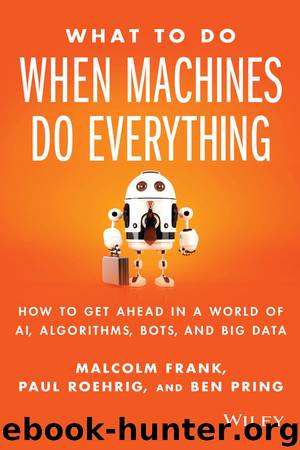What To Do When Machines Do Everything: How to Get Ahead in a World of AI, Algorithms, Bots, and Big Data by Frank Malcolm & Roehrig Paul & Pring Ben

Author:Frank, Malcolm & Roehrig, Paul & Pring, Ben [Frank, Malcolm]
Language: eng
Format: epub
ISBN: 9781119278665
Publisher: Wiley
Published: 2017-01-17T16:00:00+00:00
Identifying your automation targets will give your teams a clear path to success, but there still remains a significant hurdle in managing change within your organization. That leads to our third rule of the road.
Break Through the “Brass Wall”
OK, you may have identified your initial automation targets, which are being pursued across your industry and clearly pass the 25%–25% threshold. Everyone in your company will see the wisdom of your decision and will be fully supportive, right? Wrong.
We learned this lesson 20 years ago during the aforementioned business process reengineering (BPR) wave. Back in the 1990s, acolytes of Michael Hammer proclaimed, “Don't automate. Obliterate!” The mantra was to find ways to deliver more with less—way less.
BPR, in theory, was very sound. Yet, in most cases, the practice failed (widely soiling the name of the movement in the process). Why? Quite often, the very middle managers who were responsible for architecting and implementing BPR initiatives soon figured out they were reengineering themselves out of a job. Politics and sabotage ensued.
In hindsight, this was the “brass wall” phenomenon, which was first seen with reengineering efforts within police forces of major cities in the United States during the 1980s. During the explosion of drug-trade-related violence, police chiefs in New York, Boston, Miami, and Los Angeles all looked to establish new ways of policing (e.g., more cops walking the beat, following the “broken windows” philosophy of addressing even the smallest of crimes, leveraging data for smarter policing, and flattening the organization model to remove bureaucracy and cost). The people at the top of the policing pyramid (e.g., the police chief and his or her team, as well as municipal leaders) were hugely supportive, looking to drive the change. Young police officers, living with the frustration of the existing system, were largely supportive of these new policing techniques, as well. Yet, such change efforts were initially halted by the “brass wall”—the officers sitting in the middle of the pyramid (those with brass on their shoulders), who were at least a couple of decades into their careers, had earned their way into seniority and the power structure, and could begin to smell their pensions. To them, the perceived personal threat of such changes greatly outweighed any potential community benefits.
This brass-wall phenomenon is reappearing in today's corporate environment with digital automation initiatives. Senior employees may recognize, “Yes, automation is good for our customers and investors, but is it good for me?” Rarely are their comments so direct. Instead, you will be hit with issues, such as “That's impossible.” “It's too expensive.” “We'll get in trouble with regulators.” “We've done it this way for 50 years, and it's working fine.” “Nobody can prove the ROI today.” “We should focus our efforts elsewhere.”
This is a tough problem to solve, but solve it you must. We recommend identifying the most vocal proponents of “business as usual,” talking to them, and explaining to them the reality of what automation means for the organization. Invite them to “get with the program” and help their colleagues get with it too.
Download
This site does not store any files on its server. We only index and link to content provided by other sites. Please contact the content providers to delete copyright contents if any and email us, we'll remove relevant links or contents immediately.
Whiskies Galore by Ian Buxton(40510)
Introduction to Aircraft Design (Cambridge Aerospace Series) by John P. Fielding(32346)
Small Unmanned Fixed-wing Aircraft Design by Andrew J. Keane Andras Sobester James P. Scanlan & András Sóbester & James P. Scanlan(32148)
Craft Beer for the Homebrewer by Michael Agnew(17463)
Turbulence by E. J. Noyes(7058)
The Complete Stick Figure Physics Tutorials by Allen Sarah(6648)
Kaplan MCAT General Chemistry Review by Kaplan(6066)
The Thirst by Nesbo Jo(5793)
Bad Blood by John Carreyrou(5782)
Learning SQL by Alan Beaulieu(5424)
Weapons of Math Destruction by Cathy O'Neil(5046)
Man-made Catastrophes and Risk Information Concealment by Dmitry Chernov & Didier Sornette(4749)
iGen by Jean M. Twenge(4705)
Digital Minimalism by Cal Newport;(4568)
Life 3.0: Being Human in the Age of Artificial Intelligence by Tegmark Max(4520)
Audition by Ryu Murakami(4107)
1,001 ASVAB Practice Questions For Dummies by Powers Rod(4046)
Electronic Devices & Circuits by Jacob Millman & Christos C. Halkias(4041)
Pale Blue Dot by Carl Sagan(4017)
